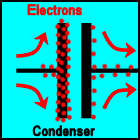THE ELECTRONIC BASIS OF MEMORY |
One can also force electrons to accumulate in a component called a condenser. The simplest form of it is 2 parallel metallic plates not in contact with each other. If one forces lots of electrons into one of the plates, on the other side the electrons will be repelled and tend to escape. (See first drawing below to the left)
That is what will happen if one applies an electric battery to the 2 sides of this condenser. Now let's add a switch (see second drawing) which opens once electrons have been forced to accumulate into one side of the condenser. These electrons are trapped because they can't get out. They tend to get out because electrons are repelling each other. In actual facts our condenser is in the state "1" (charged). If one would discharge that condenser by shortcutting the 2 plates (third drawing) the electrons which are in excess on one side will move to make up for the lack of electrons on the other side. Due to the depletion of electrons at that side the number of nuclei present there constitute a positive charge which is not balanced by the number of electrons and this will attract any electron coming from the other side until a balance is achieved between the 2 plates. The condenser is then in the state "0" (discharged). These are the memory states: 0 and 1.
 |
 |
 |
|
State 1 | State 0 |
Note that in both cases the total number of electrons is the same. It's the imbalance in the distribution of these electrons at the state 1 that causes an energy phenomenon between the 2 plates.
There are other ways to record things in 2 possible states, but this one is very key to the operation of a computer.
| |
|
| Copyright 2003-2004 Jacques Lederer |
